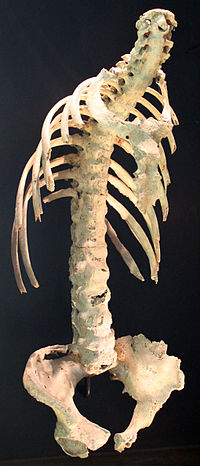
Photo from wikipedia
BackgroundSepsis-induced cardiomyopathy is a well-known cause of mortality. Recent evidence has highlighted the important role of myricetin in anti-inflammation and anti-oxidative stress. However, little is known about its effect on endotoxin-induced… Click to show full abstract
BackgroundSepsis-induced cardiomyopathy is a well-known cause of mortality. Recent evidence has highlighted the important role of myricetin in anti-inflammation and anti-oxidative stress. However, little is known about its effect on endotoxin-induced cardiomyopathy. We examined the effect of myricetin on lipopolysaccharide (LPS)-induced cardiomyocyte injury and the underlying mechanisms in vitro.MethodsmRNA expression of interleukin (IL)-1beta, IL-6, and tumor necrosis factor (TNF)-alpha was examined via reverse transcription-quantitative polymerase chain reaction (RT-qPCR). Protein expression levels of NF-κB/p65, IκB, IL-1beta, IL-6, and TNF-alpha were assesses via Western blotting. Immunofluorescence (IF) was used to determine the nuclear translocation of p65. Commercial kits were employed to detect the level of oxidative markers and to quantify NF-κB/p65 both in the cytoplasm and the nucleus. Finally, terminal deoxy-nucleotidyl transferase-mediated dUTP nick end labeling (TUNEL) was performed to evaluate the apoptosis of H9c2 cardiomyocytes.ResultsThe results showed that myricetin blunted the overexpression of IL-1beta, IL-6, and TNF-alpha markedly by inhibiting the NF-κB/P65 signaling pathway. Furthermore, myricetin treatment led to the downregulation of reactive oxygen species (ROS) accompanied by increased expression of superoxide dismutase and glutathione peroxidase. TUNEL-positive nuclei were rarely detected following myricetin treatment.ConclusionOur findings suggest that myricetin is a valuable protective agent against endotoxin-induced early inflammatory responses in H9c2 cardiomyocytes, which involves regulation of ROS and the IκB/NF-κb signaling pathway.ZusammenfassungHintergrundDie sepsisinduzierte Kardiomyopathie gehört zu den bekannten Todesursachen. Aktuelle Daten betonen die Bedeutung von Myricetin bei antientzündlichen Prozessen und antioxidativem Stress. Jedoch gibt es nur wenige Erkenntnisse zu seiner Wirkung auf die endotoxininduzierte Kardiomyopathie. Wir untersuchten nun die Wirkung von Myricetin auf lipopolysaccharid(LPS)-induzierte Kardiomyozytenläsionen und die zugrunde liegenden Mechanismen in vitro.MethodenDie mRNA-Expression von Interleukin(IL)-1beta, IL-6 und Tumornekrosefaktor(TNF)-alpha wurde mittels RT-qPCR („reverse transcription-quantitative polymerase chain reaction“) untersucht. Außerdem wurden die Proteinexpressionsspiegel von NF-κB/p65, IκB, IL-1beta, IL-6 und TNF-alpha mittels Westernblottest gemessen. Die Immunfluoreszenz (IF) wurde eingesetzt, um die nukleäre Translokation von p65 zu bestimmen. Kommerziell erhältliche Tests wurden verwendet, um die Werte für oxidative Marker zu ermitteln und NF-κB/p65 sowohl im Zytoplasma als auch im Nukleus zu quantifizieren. Schließlich wurde die TUNEL-Methode („terminal deoxy-nucleotidyl transferase-mediated dUTP nick end labeling“) angewendet, um die Apopotose von H9c2-Kardiomyozyten zu untersuchen.ErgebnisseDie Ergebnisse zeigten, das Myricetin die Überexpression von IL-1beta, IL-6 und TNF-alpha deutlich durch Inhibition des NF-κB/P65-Signalwegs abschwächte. Darüber hinaus führte die Behandlung mit Myricetin zur Herunterregulierung reaktiver Oxygenspezies (ROS), begleitet von einer erhöhten Expression der Superoxiddismutase und der Glutathionperoxidase. TUNEL-positive Nuclei wurden nach Myricetinbehandlung nur selten entdeckt.SchlussfolgerungDen vorliegenden Ergebnissen zufolge ist Myricetin eine nützliche protektive Substanz gegen endotoxininduzierte frühe entzündliche Reaktionen bei H9c2-Kardiomyozyten, wozu auch die Regulation von ROS und des IκB/NFκb-Signalwegs gehört.
Journal Title: Herz
Year Published: 2017
Link to full text (if available)
Share on Social Media: Sign Up to like & get
recommendations!